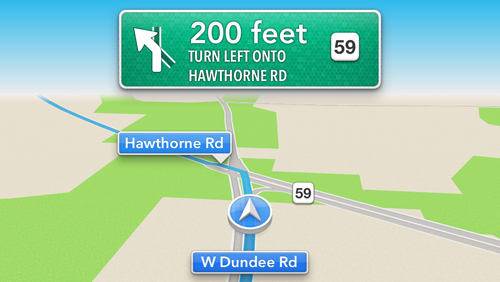iPhone 5 Turn-by-Turn Navigation vs. Android vs. Automaker


A lot has been said about the new Maps application on the iPhone 5 and the latest iPhone operating system. People say they’ve gotten lost or they can’t find the location they’re looking for and are just generally unhappy. The problems have even led the company to apologize for the app itself.
But the one function drivers covet the most about the app — turn-by-turn directions — worked exceptionally well for nearly two weeks of testing. That doesn’t mean there aren’t issues, and yes, I got lost.

I tested my iPhone 5 for one full week of regular commutes and errand runs. I also pitted it against a GMC Terrain’s optional navigation system (above) for a trip to an automaker event about 20 miles from my home. Then, on a 15-mile round trip in Chicago, I tested the iPhone against the Google Maps Navigation app on a Samsung Galaxy Note running Android 4.0.
Graphics
The first thing that stands out is just how good the app looks. The screen resolution on the iPhone 5 is stunning, and the pale yellow backgrounds of the standard maps are a good backdrop for the green road-sign direction boxes that appear for every change along the route.
Compared with a standard car-navigation screen, like the 7-inch display in the GMC Terrain Denali, the iPhone 5’s 4-inch screen looks small. But the clarity is far superior, and I didn’t have a hard time reading the directions at a similar distance as the built-in screen. The Galaxy Note’s large 5.3-inch screen looked good, too, but it was severely affected by glare from the noon sun, whereas the iPhone’s screen wasn’t.
The issue I had with the graphics came down to real estate. Whereas the car system can do a split screen to show a tricky turn or merge approaching, the iPhone 5 must rely on that green box and arrows. In landscape mode, it’s hard to see the map underneath and which way the actual route is ahead of you. In portrait mode, you generally can see the turn ahead of time, but not as well as the Samsung or GMC.
Street names appear in small, green pop-ups that are easy to read. The Samsung does a good job with street names as well, while the GMC didn’t show as many names or as clearly.
There is the well-hyped 3-D mode, and you can also pick from a standard map view, satellite view or a hybrid. I’m old-school and used the standard map in 2-D most of the time.
Routing

The most important part of a navigation system isn’t just if it gets you to your final destination — which is what many people are complaining about with the iPhone 5 — it’s whether it gets you there the fastest way possible.
The iPhone 5 offers three route choices with every destination, much like Google Maps did on the old iPhone. Google Maps Navigation didn’t offer a choice but multiple routes can be offered with a change to the settings. Some car-based systems do, generally asking if you prefer speed or tollway roads.
You can click on each route to see the estimated time of arrival and the distance change. I did find a few of the alternatives offered a bit strange, but I guess that’s why they’re alternatives.
To put the nav system truly to the test, I decided to pick an alternate route through an area of Chicago I had never visited. I had to return an appliance to a department store’s warehouse between my home and my office, and that required driving through many city streets.
I was driving blind. There were three instances where I missed turns, but only one of them was the app’s fault. In that instance, the app didn’t tell me to follow a road as it bent to the left at a disguised fork with another road allowing me to drive straight ahead. The map showed the blue highlighted route bending left, but it was covered by that large green box and the last direction, “straight.”
Luckily, the iPhone 5 reroutes rapidly — in a split second or a few dozen feet. The Samsung rerouted just as quickly during its test, while the GMC took more time.
The other two mistakes on this “blind” trip came from me thinking unmarked streets were the ones I needed to turn at. This was amplified by how close they were together — three turns in less than a typical block. The iPhone 5 also prompts you a hair later than the Samsung, giving you less time to really make a call on whether it’s the right time to turn or not. And there was one time when the iPhone told me the right way to go, and I just didn’t believe it.

While it’s hard to read the traffic on the iPhone 5 — it only shows red areas, not yellow or green — the travel times it displays were very accurate with what I hear on news radio and, well, the time I actually get home.
Voice Prompts
Plug the iPhone 5 into your car’s USB port, and not only will it use your car’s speakers to read you directions, it will also lower the volume of the stereo regardless if you’re listening to the car stereo or your iPhone-based tunes. This mimics car-based systems to a T.
Unfortunately, I tested the Samsung in only one car with USB, and the phone was not compatible with the car’s multimedia system, so I couldn’t test if the Android device has the same level of integration. Voice prompts came from the Samsung’s speaker, and the voice was definitely more robotic-sounding than the iPhone’s.
Accuracy
Here’s what everyone wants to know, right? Is it accurate?
During my tests over a few hundred miles and dozens of destinations, the iPhone 5 missed only one location. It happened to be a cow pasture in the far suburbs. The Terrain missed it, too, but the iPhone put me just 50 feet away from the farm’s highly visible road sign, while the GMC had me “arriving” a half-mile earlier.
The Samsung made a mistake, too. It kept getting confused about the location of my office in downtown Chicago. It had me going farther on a one-way street than I needed to go, and when I was feet from the door, it thought we were still blocks away. I knew I put in the correct address because the screen showed me a picture of the building’s front door via Google MapView. The iPhone 5 nailed the location, but there was no snazzy image.
This entire post had been written and edited, and the night before I was supposed to publish it, I ran into the problem many other users have experienced. The iPhone got me lost.
I needed to pick up something from a store at the last second. I searched for the nearest location on the phone. Then I called the store from the listing page on the iPhone, confirmed it had what I needed and what time it closed, and hit the road. The iPhone had the street address four miles directly east of the physical location. When I arrived at the spot it had first told me to go to, I wisely searched the maps for the street address, not the store.
It said it was six miles west of my current location.

I cursed a few times and headed the opposite direction. Three miles into the drive, I looked over to my left and saw the store I was going to, three miles short of where it should be. But I believed my eyes — I could even see the address was correct — made a quick U-turn, and walked into … the Verizon store to get a new Lighting connector since I had left mine at work. I was about to run out of juice and wouldn’t be back into the office for a few days. I explained what happened to the manager, who didn’t seem to appreciate the irony.
Overall
I had a completely different summation in the first draft of this review, but now I have to temper all the terrific results the app returned for the duration of the test with the one oddball error that had me driving all over the suburbs the other night.
The iPhone’s maps certainly are far from perfect, but the turn-by-turn navigation functions are as good as any I’ve seen.
Related
iPhone 5 Won’t Work In Your Car? We May Have the Solution
iPhone 5 Will Require Adapter in Some Cars
More Car Gadget News

Former managing editor David Thomas has a thing for wagons and owns a 2010 Subaru Outback and a 2005 Volkswagen Passat wagon.
Featured stories




